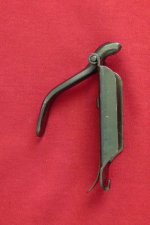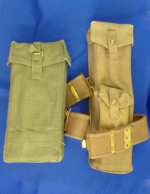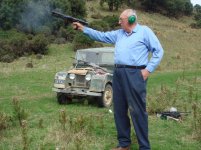This is a draft of a future article - as always, comments are welcome.
John
The British Sten submachine gun

As Britain entered World War II by declaring war on Nazi Germany in 1939, its military was woefully under-equipped with submachine guns. Their only indigenous design was the Lanchester, a wood-stocked 9mm near-copy of the German MP 28 II. The few of these available were both heavy and expensive to manufacture. America helped by providing Thompson submachine guns to their British cousins, but these were not nearly enough to meet demand. The need was evident for a lighter-weight cheap-to-manufacture 9mm subgun that could compete with the excellent German MP 38s and MP 40s, which were being used in large numbers as the war got underway. In 1941, the first of the Sten guns, the Mark I, was introduced.
The basic gun was developed from the Lanchester at Enfield Arsenal by Reginald V. Shepherd and Harold J. Turpin. The “Sten” name was a combination of the initials of the last names of these two men and the first two letters of Enfield. Because of its crude looks, it quickly acquired such nicknames as the “Stench gun,” the “plumbers delight,” or the “Woolworth gun” after the “five and dime” company that offered cheap merchandise. As first made, the gun had a wooden fore-end, a flash hider, a combination wood and stamped metal stock, and a wooden folding forward grip. A later version of the Mark I had a tubular steel stock with no wood component. The side-mounted double-column single-feed magazine mimicked the German subgun magazines. The Sten was selective fire, either full-automatic or semiautomatic from an open bolt. It was a simple blowback design with a tubular receiver, utilizing a heavy fixed-firing pin bolt and a spring for breech sealing. Still, it was more elaborate and expensive to manufacture than desired. Some attempts at producing it more economically resulted in the Mark I* (Mark I Star), which dispensed with the flash hider and substituted a stamped steel housing for the wooden fore-end. The wood forward grip was then quickly trashed as being unnecessary.
It was not long before another model of the Sten, the Mark II, was introduced. This further lightened and simplified the design. The operating handle was re-designed. The barrel and barrel jacket were both made shorter, with the barrel jacket only covering about half of the barrel. Several interchangeable butt stocks were used, the most common types being a metal “outline” version or a tubular type with a flat metal buttplate and a welded-in flat pistol grip with lightening holes. The former type is illustrated with this article on a Mark II. The Mark II also had an innovative feature in that the magazine housing could be rotated around the receiver to serve as a dust cover for the magazine opening and the ejection port. A selector button in the middle of the trigger group could be pushed back and forth laterally to provide for semiautomatic fire when pushed to the right, and automatic fire when pushed to the left. The left of the button was marked “R” for “repetition” and right of the button was marked “A” for “automatic.” The sights were fixed, calibrated for 100 yards. While there was no manual safety as such, the bolt could be locked open if the operating handle was lifted and inserted into an L-shaped portion of the handle slot in the receiver. The Mark II Sten became the most commonly used type during World War II, with over two million being produced. Here are its specifications. Caliber: 9mm Parabellum. Overall length: 30 inches. Barrel length: 7.75 inches. Magazine capacity: 32 rounds. Muzzle velocity: 1280 feet per second. Cyclic rate: 540 rounds per minute. Weight: 6.62 pounds.
A Mark II S was produced with a shorter barrel, a sound suppressor, and a lighter bolt with a shorter recoil spring. Since full-auto fire would quickly destroy the “silencer,” users were cautioned to use it in semiauto mode only, which would also be quite appropriate for clandestine use.
But wait, there’s more! An even cheaper and cruder version of the Sten was made as the Mark III. On this one, the receiver and barrel jacket were made as one long tube, and the magazine housing was welded in place. The barrel was not detachable. This was most certainly a step back in quality, but the manufacturing advantages were obvious. A Mark IV had two sub-models, and only roughly 2,000 were made. Here, the weapon was made into a more compact package. These had very short barrels and flash hiders, and were designed for use by special forces. The Model A had the trigger close to the magazine housing, in conjunction with a pistol grip. The Model B had the more conventional trigger placement. The cocking handle could be used to lock the bolt in the forward position. It appears that few if any Mark IVs were ever actually issued, however.
The last “standard” design was a return to some refinement, the Mark V. Here, a wood pistol grip was employed in conjunction with a wood stock. Early ones also had a wood vertical fore grip. The Mark Vs could also accommodate bayonets, and the front sights had protective “ears.” This version continued to be made until the adoption of the more sophisticated Sterling submachine guns in 1953.
The very last variety was the Mark VI. This was another short-barreled, suppressed gun. As with the Mark II S, semiauto-only operation was recommended.
The Stens were turned out by the millions from 1941 to 1954, with over four million being made in the ‘40s. Because their manufacture did not require a lot of sophisticated equipment, many parts were subcontracted to smaller companies that didn’t normally make munitions. In the U.K., the primary manufacturers were BSA (Birmingham Small Arms) in Tysely and Shirley, and the Royal Ordnance Factory at Fazakerley. The Sten was also made in Canada at the Long Branch Arsenal, located in Toronto.
There were some shortcomings, most of which revolved around the 32-round magazine, which was configured similarly to the 50-round Lanchester design. Not only was the double-column single-feed arrangement prone to jamming from internal friction when dirty, but it was very hard to load fully without a specially-provided magazine loader. This loader fit on the mouth of the magazine and had a pivoted finger-loop depressing lever; a later one had a simpler curved lever. The magazine for the subsequent Sterling subgun was a great improvement, using a roller-type magazine follower. That magazine was also curved to stack the rounds more uniformly, and it had a two-position feed. These things helped a lot with reliability and ease of loading. A safety problem with the Stens (until the advent of the Mark IV) was that if the bolt was in the forward position with a full magazine, the gun could fire if dropped on its butt. The bolt could move rearward enough by inertia to pick up a round from the magazine, chamber and fire it. Not good. Early Stens utilized bronze bolts, and the sear projection on these could wear easily, allowing inadvertent full-auto firing during employment. The selector buttons sometimes malfunctioned, resulting in the opposite type of fire than what was desired.
It’s strange that although the Sten was the Brits’ cheaply-made answer to the German MP 38 and MP 40 weapons, late in the war, the Germans also produced about 10,000 crude “last ditch” weapons for the volkssturm that were very similar to the Sten. These MP 3008s mostly differed in that they had bottom-position magazines. With a nod to the Brits, the U.S developed its M3 submachine gun, also designed for lighter weight and economy. Copies and variants of the Sten were produced by many nations, including Australia, where their version was called the Austen. It incorporated fore and aft vertical pistol grips, and was made at the Lithgow Small Arms Factory.
The Sten had a fairly good record in combat, and was prolifically used in both the European and Far East theaters during WWII. British and Canadian troops used them during the D-Day invasion of Normandy. Many were air-dropped to partisans in occupied France during the war, and there are numerous photographs of these arms being used in the liberation of Paris. Stens and Sten copies made around the world have been used in combat by many national and guerilla forces even to the present day. They were milestones in small arms design, and richly deserve to be called classics.
(c) 2016 JLM
John
The British Sten submachine gun

As Britain entered World War II by declaring war on Nazi Germany in 1939, its military was woefully under-equipped with submachine guns. Their only indigenous design was the Lanchester, a wood-stocked 9mm near-copy of the German MP 28 II. The few of these available were both heavy and expensive to manufacture. America helped by providing Thompson submachine guns to their British cousins, but these were not nearly enough to meet demand. The need was evident for a lighter-weight cheap-to-manufacture 9mm subgun that could compete with the excellent German MP 38s and MP 40s, which were being used in large numbers as the war got underway. In 1941, the first of the Sten guns, the Mark I, was introduced.
The basic gun was developed from the Lanchester at Enfield Arsenal by Reginald V. Shepherd and Harold J. Turpin. The “Sten” name was a combination of the initials of the last names of these two men and the first two letters of Enfield. Because of its crude looks, it quickly acquired such nicknames as the “Stench gun,” the “plumbers delight,” or the “Woolworth gun” after the “five and dime” company that offered cheap merchandise. As first made, the gun had a wooden fore-end, a flash hider, a combination wood and stamped metal stock, and a wooden folding forward grip. A later version of the Mark I had a tubular steel stock with no wood component. The side-mounted double-column single-feed magazine mimicked the German subgun magazines. The Sten was selective fire, either full-automatic or semiautomatic from an open bolt. It was a simple blowback design with a tubular receiver, utilizing a heavy fixed-firing pin bolt and a spring for breech sealing. Still, it was more elaborate and expensive to manufacture than desired. Some attempts at producing it more economically resulted in the Mark I* (Mark I Star), which dispensed with the flash hider and substituted a stamped steel housing for the wooden fore-end. The wood forward grip was then quickly trashed as being unnecessary.
It was not long before another model of the Sten, the Mark II, was introduced. This further lightened and simplified the design. The operating handle was re-designed. The barrel and barrel jacket were both made shorter, with the barrel jacket only covering about half of the barrel. Several interchangeable butt stocks were used, the most common types being a metal “outline” version or a tubular type with a flat metal buttplate and a welded-in flat pistol grip with lightening holes. The former type is illustrated with this article on a Mark II. The Mark II also had an innovative feature in that the magazine housing could be rotated around the receiver to serve as a dust cover for the magazine opening and the ejection port. A selector button in the middle of the trigger group could be pushed back and forth laterally to provide for semiautomatic fire when pushed to the right, and automatic fire when pushed to the left. The left of the button was marked “R” for “repetition” and right of the button was marked “A” for “automatic.” The sights were fixed, calibrated for 100 yards. While there was no manual safety as such, the bolt could be locked open if the operating handle was lifted and inserted into an L-shaped portion of the handle slot in the receiver. The Mark II Sten became the most commonly used type during World War II, with over two million being produced. Here are its specifications. Caliber: 9mm Parabellum. Overall length: 30 inches. Barrel length: 7.75 inches. Magazine capacity: 32 rounds. Muzzle velocity: 1280 feet per second. Cyclic rate: 540 rounds per minute. Weight: 6.62 pounds.
A Mark II S was produced with a shorter barrel, a sound suppressor, and a lighter bolt with a shorter recoil spring. Since full-auto fire would quickly destroy the “silencer,” users were cautioned to use it in semiauto mode only, which would also be quite appropriate for clandestine use.
But wait, there’s more! An even cheaper and cruder version of the Sten was made as the Mark III. On this one, the receiver and barrel jacket were made as one long tube, and the magazine housing was welded in place. The barrel was not detachable. This was most certainly a step back in quality, but the manufacturing advantages were obvious. A Mark IV had two sub-models, and only roughly 2,000 were made. Here, the weapon was made into a more compact package. These had very short barrels and flash hiders, and were designed for use by special forces. The Model A had the trigger close to the magazine housing, in conjunction with a pistol grip. The Model B had the more conventional trigger placement. The cocking handle could be used to lock the bolt in the forward position. It appears that few if any Mark IVs were ever actually issued, however.
The last “standard” design was a return to some refinement, the Mark V. Here, a wood pistol grip was employed in conjunction with a wood stock. Early ones also had a wood vertical fore grip. The Mark Vs could also accommodate bayonets, and the front sights had protective “ears.” This version continued to be made until the adoption of the more sophisticated Sterling submachine guns in 1953.
The very last variety was the Mark VI. This was another short-barreled, suppressed gun. As with the Mark II S, semiauto-only operation was recommended.
The Stens were turned out by the millions from 1941 to 1954, with over four million being made in the ‘40s. Because their manufacture did not require a lot of sophisticated equipment, many parts were subcontracted to smaller companies that didn’t normally make munitions. In the U.K., the primary manufacturers were BSA (Birmingham Small Arms) in Tysely and Shirley, and the Royal Ordnance Factory at Fazakerley. The Sten was also made in Canada at the Long Branch Arsenal, located in Toronto.
There were some shortcomings, most of which revolved around the 32-round magazine, which was configured similarly to the 50-round Lanchester design. Not only was the double-column single-feed arrangement prone to jamming from internal friction when dirty, but it was very hard to load fully without a specially-provided magazine loader. This loader fit on the mouth of the magazine and had a pivoted finger-loop depressing lever; a later one had a simpler curved lever. The magazine for the subsequent Sterling subgun was a great improvement, using a roller-type magazine follower. That magazine was also curved to stack the rounds more uniformly, and it had a two-position feed. These things helped a lot with reliability and ease of loading. A safety problem with the Stens (until the advent of the Mark IV) was that if the bolt was in the forward position with a full magazine, the gun could fire if dropped on its butt. The bolt could move rearward enough by inertia to pick up a round from the magazine, chamber and fire it. Not good. Early Stens utilized bronze bolts, and the sear projection on these could wear easily, allowing inadvertent full-auto firing during employment. The selector buttons sometimes malfunctioned, resulting in the opposite type of fire than what was desired.
It’s strange that although the Sten was the Brits’ cheaply-made answer to the German MP 38 and MP 40 weapons, late in the war, the Germans also produced about 10,000 crude “last ditch” weapons for the volkssturm that were very similar to the Sten. These MP 3008s mostly differed in that they had bottom-position magazines. With a nod to the Brits, the U.S developed its M3 submachine gun, also designed for lighter weight and economy. Copies and variants of the Sten were produced by many nations, including Australia, where their version was called the Austen. It incorporated fore and aft vertical pistol grips, and was made at the Lithgow Small Arms Factory.
The Sten had a fairly good record in combat, and was prolifically used in both the European and Far East theaters during WWII. British and Canadian troops used them during the D-Day invasion of Normandy. Many were air-dropped to partisans in occupied France during the war, and there are numerous photographs of these arms being used in the liberation of Paris. Stens and Sten copies made around the world have been used in combat by many national and guerilla forces even to the present day. They were milestones in small arms design, and richly deserve to be called classics.
(c) 2016 JLM
Last edited:







